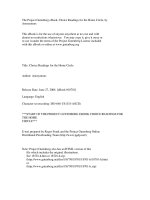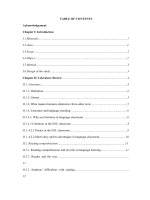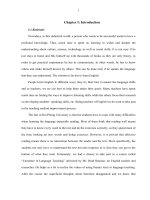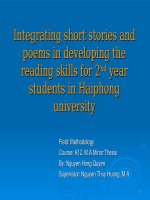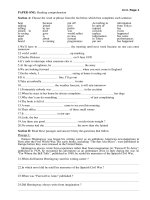u9 reading
Bạn đang xem bản rút gọn của tài liệu. Xem và tải ngay bản đầy đủ của tài liệu tại đây (119.12 KB, 2 trang )
<span class='text_page_counter'>(1)</span>UNIT 9: UNDERSEA WORLD. Lesson 1: READING Objectives: By the end of the lesson, Students will be able to gain some knowledge on undersea world, and master some Voc. Materials: Textbook, picture, chalk,… Time 7’. 5’. . Contents Warm up: Guessing game. - What is the word? It cover most of the earth surface. OCEAN How many oceans are there on the world? ……. Page 94. Gives out the location for each ocean. Pre teach: Look at the pictures on page 94, then name the animal in each picture. 1. SEAL. 8’. -. 10’. 4. SHARK. Pre reading:. A bay Marine life Independent An organism A current To contribute To be at stake . 8’. 2. JELLY FISH 3. TURTLE. [bei] [mə'ri:n] [indi'pendənt] (a) ['ɔ:gənizm] ['kʌrənt] [kən'tribju:t] (exp). : vịnh : đời sống biển : độc lập : sinh vật : hải lưu : đóng góp: : bị đe dọa. T’s and Ss’ activities - T gives instruction and Ss guess the word letter by letter. - T elicits the new lesson.. - T asks Ss to give out the name of the animals. - Ss answer orally and T gives feedback. - Practise the words. -. explanation eliciting example explanation explanation translation translation. While reading:. Task 1: The words in the box all appear in the passage. Fill each blank with one of them. There are more words then needed. 1.. Some plants and animals are referred to as tiny organism because they are extremely small.. 2.. Thanks to modern technology, scientists have been able to investigate the life of plants and animals that live under the sea.. 3.. A gulf is a large area of sea that is partly surrounded by land.. 4.. Biodiversity is a term that refers to the existence of different kind s of animals and plants which made a balanced environment.. 5.. These scientists have collected different samples to analyze for their experiment.. Task 2: read the passage again and answer the questions: 1. What percentage of the earth’s surface is covered by seas and oceans? 75% 2. How do scientists now overcome the challenges of the depth? By using modern devices. 3. What can we learn from the satellite photos? We can know a wide range of information, including water temperature, depth and the undersea population. 4. What are the three groups of marine plants and animals?. - T runs through the words in the box, then asks Ss to do it. - Ss work in groups and translate the sentences to have the correct answers. - Ss answer orally T gives feedback.. - T asks S read aloud the questions, then monitors Ss to do the task. - Ss work individual pairs. - Ss answer orally, others listen and gives feedback with the T. - T guides Ss to answer themselves at home..
<span class='text_page_counter'>(2)</span> They are those that live on or depend on the bottom like starfish, move independently of water currents and carried along by the currents. 5. What would happen if the sea biodiversity were not maintained? Marine life would be at stake.. 7’. . Post reading:. Complete the summary of the reading passage by filling each blank with a word. Nowadays, scientists overcome many of challenges the depth by using modern devices. They use submarines to investigate undersea world. Besides, satellite photographs supply us with a wide range of information, including water temperature, depth and the undersea populations. Homework:. - Ss do not allow opening their book. - Ss work in groups and translate the paragraph after having the answers. - T monitors and feedbacks.. Answer the questions and prepare vocabulary for speaking.. Tân Châu, ……/……/2011 Tổ trưởng. Nguyễn Thị Tiến.
<span class='text_page_counter'>(3)</span>
